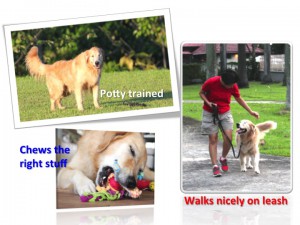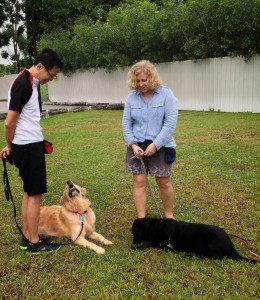Insights from a non-dog person…listen well!
Jining and I were having lunch today in sunny LA, and I again bemoaned the fact that many dog owners and supposed dog lovers alike, seem to zero in on the most inappropriate training tactics for their fearful or reactive dogs.
Sharp neck jabs, hitting the dog with rolled up newspapers, shouting, harsh or stern reprimands, neck scruffs, putting a dog on a high stool as punishment, alpha rolls, exerting dominance over the dog, being the pack leader etc. Every time I ask a troubled dog owner, about how they have been training their dogs, I get a variation of the above list. Each time, I cringe, each time I fear for the safety of the dog and the people around it. And for some reason, these owners don’t consider these actions as punishment – they are just ‘disciplining’ their wayward dogs. For the record, oh yes, they are forms of punishment!
In her usual no-nonsense way, Jining explained to me how, as a non-dog person, when she first saw a certain TV dog training show, she, like so many others, thought it was a refreshing take on our relationship with dogs. Yes, we shouldn’t spoil our dogs, yes, we should treat them as dogs, yes, we should be the leader – tell the dog and it obeys, just like that. It was a seductive argument, it seems to work (at least on TV), sometimes it works in real life, and we seldom hear about any fall-out (probably because they don’t get shown on TV), but surface as calls for help to trainers like me, who have to try and pick up the pieces.
But since then, she has become ‘enlightened’ and seen through the flawed arguments, and in doing so, equipped me with a way to explain her insight into our relationship with our dogs. Here goes:
1. Pack Leader: The glamour has centered on stroking our ego – we are leaders, we lead, our dogs follow. Sounds good.
What has been left out is that being a leader carries great responsibilities:
(a) As a leader, have we taught our dog about what we would like it to do, in a way that the dog can understand and obey willingly? Other than coercing a dog into submission?
(b) As a leader, have we made the effort to understand each situation into which we expect our dog to follow, and set it up such that it’s safe and the dog can succeed in what we’ve taught it to do? Or do we just throw them into the deep end of the pool?
Ask yourself: would you prefer to follow a benevolent leader who takes responsibility and has prepared the “battleground” to maximize chances of success, or one who gives no constructive instructions, but screams and shouts when things go wrong?
 |
| Being a dog’s leader means teaching it to make good choices, by teaching your dog what to do, rather than stop doing what you don’t want |
2. Treat A Dog Like A Dog: This is actually true, but not in the way that has been interpreted – as an animal that must be made to obey. If it does, we love it, if it doesn’t, we coerce it or punish it into submission, because we are supposed to be dominant, aren’t we?
What has been left out:
Treating a dog like a dog means that we make the effort to understand a dog’s behavior – to know when it’s stressed and hence unable to cope with a certain situation; to know when it’s comfortable and hence able to cope; to understand how dogs learn and can enjoy learning if we communicate in ways that the dog understands and finds rewarding, and hence more likely to “obey”.
Ask yourself: would you prefer to do something that’s rewarding and makes you feel good, or something that makes you feel scared, but you don’t dare to disobey because bad things will happen to you?
 |
| Rose (R) is dog-dog reactive. Margaret, her leader, has chosen the path of guiding Rose by understanding her behaviour, rather than correcting Rose for reacting. Look at her smile at Rose’s achievement, where before, there were tears |
3. Love is Enough: I’m sure each and every one of these troubled dog owners started off loving their dogs. “Tough love” they sometimes call it – we love you and will let you do anything you want, until you do something we don’t like. Then out comes the discipline rod. After all, dogs love to please us.
What has been left out:
I’m sorry to burst the bubble, but dogs love to please themselves.
By vacillating between “tough love” and “letting the dog do what it likes as long as it doesn’t irk us”, we create uncertainty and anxiety in the dog. We send mixed signals to our dog – “why is it ok to bark sometimes (and get praised for being a good guard dog) and it’s not ok to bark when someone scares me, and I’m growling to show I’m scared, I really don’t want to pick a fight but I really need some space”?
Love alone isn’t enough – if you truly love your dog, the discipline comes from within you.
(a) Reward your dog for good behaviors so that it’s more likely to repeat them
(b) Teach your dog something else to do that you do like so that it can do that instead of something that you don’t like
(c) Be generous in your praise and rewards
(d) Help your dog succeed by working in small steps, rather than big ones.
Ask yourself: do you feel safer with someone who knows what they’re doing, or someone who has mood swings?
 |
| Is Jeff “slave” to Kiyo? Not at all, but part of a leader’s responsibilities is to ensure a dog’s comfort. When a dog isn’t stressed (physically and mentally), it’s more likely to enjoy what it’s doing |
In summary
Our relationship with our dog is one fraught with obstacles:
- The language barrier – no, dogs don’t come programmed to understand what we say, not matter how loudly we say it;
- The language barrier – we don’t come programmed to understand our dogs too, so we need to learn
- The language barrier – while punishment can stop a behavior, often all it does is expose the tip of the iceberg. Dogs have a fairly high level of tolerance for our mistakes but when we continually swamp them with conflicting signals, at some point, they would reach their limit of tolerance, and something will happen. Usually something not good.
- The language barrier – instead of waiting until all modes of communication have broken down, take responsibility as a leader and learn to work with your dog as a team. Collaborative, rather than top-down dictatorship.
 |
| Who’s dominant, who’s submissive? Who cares? We’re a team and learn from each other |
 |
| Ah, I miss Kiyo, even when he’s doing something as unglamourous as peeing :)! |

